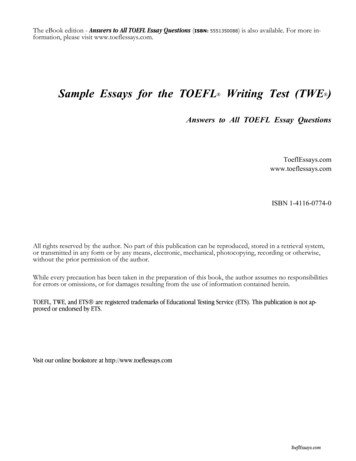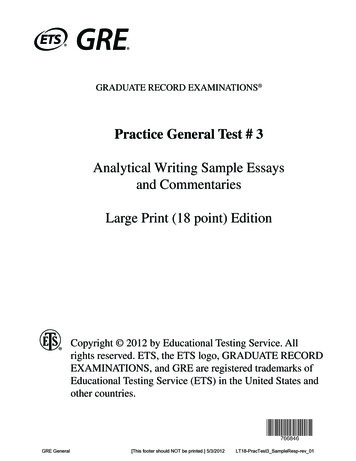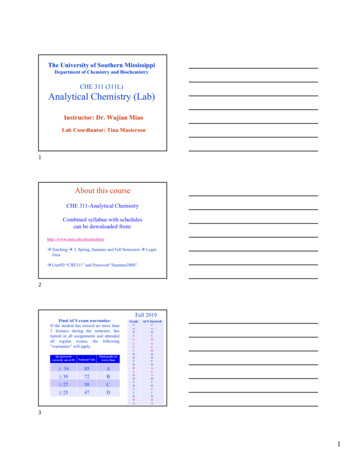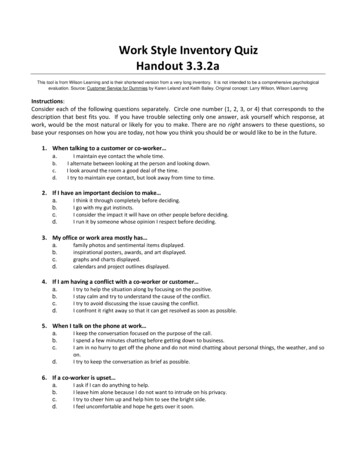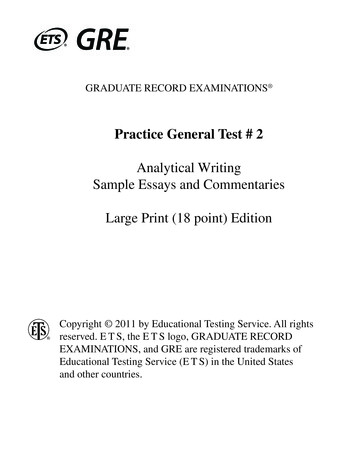
Transcription
GRADUATE RECORD EXAMINATIONS Practice General Test # 2Analytical WritingSample Essays and CommentariesLarge Print (18 point) EditionCopyright 2011 by Educational Testing Service. All rightsreserved. E T S, the E T S logo, GRADUATE RECORDEXAMINATIONS, and GRE are registered trademarks ofEducational Testing Service (E T S) in the United Statesand other countries.
Revised GRE Practice Test 2Analytical Writing Sample Essays withReader CommentariesThe Analytical Writing portion of the GRE test consistsof two writing topics, an Issue topic and an Argumenttopic. This document contains the writing topics forPractice Test 2, the scoring guides for each section,and sample responses with commentaries for eachtopic.Note: Sample responses are reproduced exactly aswritten, including misspellings, wrong choice of words,typographical and grammatical errors, etc., if any.-2-
Analyze an IssueSample Issue Topic DirectionsYou will be given a brief quotation that states orimplies an issue of general interest and specificinstructions on how to respond to that issue. Plan andcompose a response in which you develop a positionon the issue according to the specific instructions.A response to any other issue will receive a score ofzero. Standard timing for an issue topic is 30 minutes.Make sure that you respond to the specific instructionsand support your position on the issue with reasonsand examples drawn from such areas as your reading,experience, observations, and/or academic studies.-3-
Trained GRE readers will read your response andevaluate its overall quality according to how wellyou do each of the following: Respond to the specific instructions Consider the complexities of the issue Organize, develop, and express your ideas Support your position with relevant reasonsand/or examples Control the elements of standard written EnglishBefore you begin writing, you may want to think for afew minutes about the issue and the instructions andthen plan your response. Be sure to develop yourposition fully and organize it coherently, but leave timeto reread what you have written and make anyrevisions you think are necessary.-4-
Sample Issue Topic:“The best way to teach is to praise positiveactions and ignore negative ones.”Write a response in which you discuss theextent to which you agree or disagree with therecommendation and explain your reasoningfor the position you take. In developing andsupporting your position, describe specificcircumstances in which adopting therecommendation would or would not beadvantageous and explain how these examplesshape your position.-5-
GRE Scoring Guide: Analyze an IssueScore 6In addressing the specific task directions, a 6 paperpresents a cogent, well-articulated analysis of theissue and conveys meaning skillfully.A typical paper in this category exhibits the followingcharacteristics:1.It articulates a clear and insightful position onthe issue in accordance with the assigned task.2.It develops the position fully, with compellingreasons and/or persuasive examples.3.It sustains a well-focused, well-organizedanalysis, connecting ideas logically.4.It conveys ideas fluently and precisely, usingeffective vocabulary and sentence variety.5.It demonstrates facility with the conventions ofstandard written English (i.e., grammar, usage,and mechanics) but may have minor errors.-6-
Score 5In addressing the specific task directions, a 5 paperpresents a generally thoughtful, well-developedanalysis of the issue and conveys meaning clearly.A typical paper in this category exhibits the followingcharacteristics:1.It presents a clear and well-considered positionon the issue in accordance with the assignedtask.2.It develops the position with logically soundreasons and/or well-chosen examples.3.It is focused and generally well organized,connecting ideas appropriately.4.It conveys ideas clearly and well, usingappropriate vocabulary and sentence variety.5.It demonstrates facility with the conventions ofstandard written English but may have minorerrors.-7-
Score 4In addressing the specific task directions, a 4 paperpresents a competent analysis of the issue andconveys meaning with acceptable clarity.A typical paper in this category exhibits the followingcharacteristics:1.It presents a clear position on the issuein accordance with the assigned task.2.It develops the position with relevant reasonsand/or examples.3.It is adequately focused and organized.4.It demonstrates sufficient control of languageto express ideas with reasonable clarity.5.It generally demonstrates control of theconventions of standard written English butmay have some errors.-8-
Score 3A 3 paper demonstrates some competence inaddressing the specific task directions, in analyzingthe issue, and in conveying meaning but is obviouslyflawed.A typical paper in this category exhibits ONE OR MOREof the following characteristics:1.It is vague or limited in addressing the specifictask directions and in presenting or developinga position on the issue.2.It is weak in the use of relevant reasons orexamples, or relies largely on unsupportedclaims.3.It is poorly focused and/or poorly organized.4.It has problems in language and sentencestructure that result in a lack of clarity.5.It contains occasional major errors or frequentminor errors in grammar, usage, or mechanicsthat can interfere with meaning.-9-
Score 2A 2 paper largely disregards the specific task directionsand/or demonstrates serious weaknesses in analyticalwriting.A typical paper in this category exhibits ONE OR MOREof the following characteristics:1.It is unclear or seriously limited in addressingthe specific task directions and in presentingor developing a position on the issue.2.It provides few, if any, relevant reasons orexamples in support of its claims.3.It is unfocused and/or disorganized.4.It has serious problems in language andsentence structure that frequently interferewith meaning.5.It contains serious errors in grammar, usage,or mechanics that frequently obscure meaning.-10-
Score 1A 1 paper demonstrates fundamental deficiencies inanalytical writing.A typical paper in this category exhibits ONE OR MOREof the following characteristics:1.It provides little or no evidence of understandingthe issue.2.It provides little or no evidence of the ability todevelop an organized response.3.It has severe problems in language and sentencestructure that persistently interfere withmeaning.4.It contains pervasive errors in grammar, usage,or mechanics that result in incoherence.-11-
Score 0A 0 paper is off topic (i.e., provides no evidenceof an attempt to respond to the assigned topic),written in a foreign language, merely copies thetopic, consists of only keystroke characters, or isillegible or nonverbal.Sample Responses to the Issue Topic,with Reader CommentariesThe following are sample responses and commentaryon those responses, which explain how each responsewas scored. There are responses and scoringcomments for essays with scores of 6, 5, 4, 3, 2,and 1.Reminder: Sample responses are reproduced exactlyas written, including misspellings, wrong choice ofwords, typographical and grammatical errors, etc.,if any.-12-
The following sample issue responsereceived a score of 6:The recommendation presents a view that I wouldagree is successful most of the time, but one thatI cannot fully support due to the “all or nothing”impression it gives.Certainly as an educator I agree fully that the bestway to elicit positive response from students is tomake use of students’ positive energy and thenencourage actions that you would like to see repeated.It is human nature that we all want to be accepted andachieve on some level, and when people in authorityprovide feedback that we have done something well,the drive to repeat the action that was praised isbound to be particularly strong.This blanket statement would obviously pay dividendsin situations in which a teacher desires to havestudents repeat particular behaviors. For example,if an educator is attempting to teach students-13-
proper classroom etiquette, it would be appropriateto openly praise a student who raises his or her handwhen wishing to speak or address the class. In suchcases, the teacher may also help shape positivebehaviors by ignoring a student who is trying tointerject without approval from the teacher. In fact,the decision to ignore students who are exhibitinginappropriate behaviors of this type could work verywell in this situation, as the stakes are not very highand the intended outcome can likely be achieved bysuch a method. However, it is important to notehere that this tactic would only be effective in sucha “low-stakes” situation, as when a student speakswithout raising her hand first. As we will discussbelow, ignoring a student who hits another student,or engages in more serious misbehaviors, would notbe effective or prudent.To expand on this point, it is important for teachersto be careful when working with the second half ofthis statement, only ignoring negative actions thatare not serious. Take for instance a student who is-14-
misbehaving just by chatting with a fellow classmate.This student might not be presenting much of aproblem and may be simply seeking attention.Ignoring the student might, in fact, be the bestsolution. Now assume the negative action is theimproper administering of chemicals in a scienceexperiment or the bullying of a fellow student. Toignore these negative actions would be absurd andnegligent. Now you are allowing a problem to persist,one that could potentially lead to much bigger andmore dangerous issues. In a more serious situation,addressing the negative actions quickly and properlycould stop the problem it in its tracks. It is for reasonslike this that I do not advocate the idea that a teachercan be successful by simply ignoring negative actions.I do, however, greatly support the idea that thecentral focus of teaching should be to build on andencourage positive actions. However, the author’sall-encompasing statement leaves too many negativepossibilities for the classroom. Perhaps a better wayto phrase this statement would be to say, “The best-15-
way to teach is to praise positive actions and ignorenegative ones that are not debilitating to classefficiency or the safety of any individual”.Thus, in the original statement, there are indeed somegood intentions, and there could be a lot of merit inadopting its basic principles. Data proves that positivesupport can substantially increase motivation anddesire in students and contribute to positiveachievements. In fact, most studies of teachingefficacy indicate that praising positive actions andignoring negative ones can create a more stable andefficient classroom. It needs to be stressed, however,that this tool is only effective at certain levels ofmisbehavior. As mentioned above, when the behavioris precipitated by feelings of revenge, power or totalself-worthlessness, this methodology will likely notwork. It is likely to be very successful, however, when-16-
the drive behind the misbehavior is simple attentionseeking. In many of these instances, if the teacherdemonstrates clearly that inappropriate behaviordoes not result in the gaining of attention, studentsare more likely to seek attention by behaving properly.Should the student choose this path, then the ignoringhas worked and when the positive behavior isexhibited, then the teacher can utilize the first part ofthe theory and support or praise this behavior. Nowit is much more likely to be repeated. If the studentdoes not choose this path and instead elects to raisethe actions to a higher level that presents a moreserious issue, then ignorance alone cannot workand other methods must be employed.In conclusion, one can appreciate the credo expressedin this instance, but surely we all can see the potentialerror of following it through to the extreme.-17-
Comments on sample essay receivingscore of 6:This response receives a 6 for its well-articulated,insightful analysis of the issue. Rather than simplyrejecting or accepting the prompt, the writer arguesthat the recommendation made by the prompt canoften be true but is too “all or nothing” to be endorsedwithout qualification. The writer turns this idea intoan insightful position by providing examples andevidence to fully and persuasively support its nuancedargument. The response provides nicely detailedsituations that offer compelling support for a claimthat the recommendation can, in fact, work. At thesame time, it also highlights the recommendation’slimits using additional specific, detailed examples.Particularly persuasive is the fourth paragraph, inwhich the writer compares the impact of ignoringminor behavioral problems like talking in class tothe potential costs of ignoring more serious issueslike bullying. Thus, the writer recognizes that theprompt’s claim, as well as his/her own, is inevitablydependent on the specific context for its success or-18-
failure. Throughout the response, the writerdemonstrates the ability to convey ideas fluently andprecisely, using effective vocabulary and sentencevariety. This sentence demonstrates the level oflanguage facility seen throughout the response: “It ishuman nature that we all want to be accepted andachieve on some level, and when people in authorityprovide feedback that we have done something well,the drive to repeat the action that was praised isbound to be particularly strong.”-19-
The following sample issue responsereceived a score of 5:I partially agree with the statement “The best wayto teach is to praise positive actions and ignorenegative ones”. Children should be rewarded whenthey perform well; however, they should not beignored for performing sub-optimally. For purposesof this essay, the term “actions” is defined asbehaviors within the classroom.Utilizing positive reinforcements, such as tangiblerewards, can be a good method to teach children.If the teacher praises children for actions that aredesirable, then the children are more likely to repeatthose actions. For example, a student who completesan assignment on time and does a good job is likelyto want to do a good job on the next assignment if hegets positive feedback. Likewise, the children who arenot currently engaging in the desirable actions may bemore inclined to do so in order to recieve the positivereinforcement.-20-
Conversely, children should not be ignored for negativeactions. If a child is not exhibiting appropriate behaviorin the classroom, then it is the teacher’s responsibilityto encourage the child to perform optimally. Ignoringsomething doesn’t make it go away, actions andconsequences do. A student who is being disruptive inclass will continue to be disruptive unless the teacherdoes something about it. However, the teacher’sactions need be appropriate.Before the teacher attempts to modify a child’sbehavior, the teacher needs to try and identify thereason behind the behavior. For instance, childrenwho leave their seat often, stare in to space, or callout of turn may be initially viewed as having poorbehavior. However, the teacher may suspect thatthe child has an attentional problem, and requestthat the child be tested. If the child does have anattentional problem, then the teacher can work witha related service, such as occupational therapy, toalter the classroom environment in order to caterto the needs of the child. For instance, the teachercould remove some of the stimulating bulliten board-21-
displays to make the room more calming to the child.If the child becomes more attentive in class then theteacher was able to assist the child without scorningthem or ignoring them. The teacher met the needs ofthe child and created an enviornment to enable thechild to optimally perform in the educational setting.On the other hand, if the child is tested, and does nothave any areas of concern that may be impacting theeducational performance in the classroom, then thenegative behavior may strictly be due to defiance.In such a case, the teacher still should not ignorethe child, because the negative actions may hinderthe learning opportunity for the remaining children inthe class. As a result, a child who is being disruptiveto the learning process of the class should be set apartfrom the class so that they do not receive the positivereinforcement of peer attention.The teacher should not ignore the student who ismisbehaving, but that does not mean that the teacherjust needs to punish. It is better to address the child-22-
privately and make sure the child is aware of thenegative actions. Once the child is aware, then theteacher should once again try to determine the reasonwhy the child is behaving in a negative manner.Perhaps the child’s parents are in the middle of adivorce and the child is outwardly expressing hisfrustration in the classroom. Or the academic contentof the class may not be challenging enough for thechild and so he is misbehaving out of boredom.Whatever the reason behind the behavior, the keyfactor is that the teacher works with the child to tryand identify it. Simply punnishing or ignoring thechild would not solve the problem, whereas workingto create a plan for success in the classroom would.Likewise, rather than punnishing and defeating thechild, the teacher is working with and empowering thechild; a much more positive outcome to the situation.-23-
Comments on sample essay receivingscore of 5:This strong response presents a thoughtful and welldeveloped analysis of the issue. In this case the writerargues that teachers need to modify their approachbased on context and observation, meaning that ablanket approach cannot be successful. The writersupports this position with relevant reasons andexamples that present logically sound support. Notethat the task instructions ask writers to discusssituations in which the statement might or might nothold true, and this response does that quite clearly.In the second paragraph, the writer gives an exampleof a student who completes an assignment on timeand receives positive feedback, showing how therecommendation could hold true. Other examplesshow situations in which it might not hold true, andthese various points are brought together to support-24-
the writer’s position that teachers have to look atthe context of the situation and cannot rely on simplyignoring negative actions. This response alsodemonstrates facility with language, using appropriatevocabulary and sentence variety. Sentences like thisone demonstrate the writer’s command of theconventions of standard written English: “If the childdoes have an attentional problem, then the teachercan work with a related service, such as occupationaltherapy, to alter the classroom environment in orderto cater to the needs of the child.” There are someminor errors, but overall the response demonstratesstrong control of language. Although the response isclearly stronger than a 4, which would simply presenta clear position on the issue according to the taskinstructions, it does not reach the level of a 6 becauseit does not develop its points in a way that createsa cogent and insightful position. It does, however,present a generally thoughtful and well-developedanalysis of the issue, leading to a score of 5.-25-
The following sample issue responsereceived a score of 4:I absolutely agree with the first section of thestatement above, but find fault with the latter half.There is no doubt that praising positive actions isan excellent way to teach, and this method is mostclearly exemplified when dealing with much youngerchildren. When a young child is learning basic socialbehavior, it is imperative that he is encouraged torepeat positive actions. For example, when a childvoluntarily shares his toys with another, if a teacherrewards that behavior, the child will understand thatthis is a good practice, and likely share again inthe future.In contrast, if a child displays negative behavior bystealing a toy away from his playmate, it would bevery dangerous for the teacher to ignore this action,-26-
for then the child may never recognize that this isunacceptable. In this instance, the child has notlearned from the situation at all. So what shoulda teacher do when faced with such a situation?Punishment is not necessarily the optimal choice,either. Rather than scolding a child for mistreatinghis playmates and sending him off to a corner,a teacher would be wise to demonstrate the positivealternative: to share his toys instead. In this case,rather than ignoring or punishing negative actions,the teacher could seize the opportunity to reinforcepositive behavior, and further extend the child’slearning experience.In summary, positive reinforcement is certainlyan excellent method for teaching new methods orbehaviors, and encouraging a student to learn more.However to ignore, rather than recognize and correctnegative actions, would be a disservice to the student,for he would not know what conclusion to draw fromhis action.-27-
Comments on sample essay receivingscore of 4:This adequate response follows the task directions andpresents a clear position on the issue, supporting itsmain points with examples that are relevant, if onlyadequately developed. For instance, the discussionin the second paragraph of a teacher who reinforcesthe positive behavior of sharing a toy is certainlyrelevant and on-task (i.e., it describes a situationin which adopting the recommendation would beadvantageous). However, the development of thisidea does not lead to generally thoughtful or insightfulanalysis. Instead, it is simply presented as anexample. In addition to its adequate development,this response also demonstrates sufficient control ofthe conventions of standard written English, and itsmain points are made with reasonable clarity. Someof the sentences demonstrate the syntactical varietynormally seen in responses that receive higher scores(e.g., “Rather than scolding a child for mistreating his-28-
playmates and sending him off to a corner, a teacherwould be wise to demonstrate the positive alternative:to share his toys instead”). However, the overall useof language in this response is merely adequate.The following sample issue responsereceived a score of 3:Praising postive actions and ignoring negative onesmay be a good way to teach but not the best way.Ignoring negative actions could negate all the postivepraises given to an individual, having negative actionsgo unchecked will lead to habits formed that wouldoverwhelm any positive actions that arecomplementary to an individuals learning process.For instance, in a classroom full of eight-year old kids;if during a lesson they are making alot of noise, havingthis ignored would tell the kids that it is okay to bedisruptive in class. The individuals in that class woulddevelop the habit of being distruptive hence hindering-29-
their learning process. However if the eight-year oldkids were immediately told to stop the distruptionthen it will never become a habit.Every action needs to have a related consequencefollow in a learning environment. In the earlyyears of education, the way they are taught becomesa lifelong habit which is hard to change in later years.If negative actions are not assigned a relatedconsequences then teaching becomes ineffectivebecause the students negative actions soon diminishthe ability to do well in school. The way postive actionsare dealt with should also be done with negativeactions rather than being ignored which in turnenhance the learning environment.Comments on sample essay receivingscore of 3:Although this response has minor errors in its use oflanguage, it receives a 3 primarily for insufficientoverall clarity and for the limited development of its-30-
claims. The writer does make an attempt to follow thespecific task instructions, and the response has a clearposition on the issue, arguing that it is not acceptablepractice to ignore negative behaviors. However, thedevelopment provided in support of that position islimited. The example of “eight-year old kids” makingnoise during class can be seen as a situation in whichfollowing the recommendation is not advantageous.Instead of developing that point in a logicallypersuasive way, however, the writer proceeds to makean unsupported assertion about the consequences offollowing the recommendation (“The individuals in thatclass would develop the habit of being distruptivehence hindering their learning process”). Anotherissue that keeps this response at the 3 level is a lackof clarity, particularly in the final paragraph. The finalsentence demonstrates this problem with clarity: “Theway postive actions are dealt with should also be donewith negative actions rather than being ignored whichin turn enhance the learning environment.” Problemswith the structure of this sentence make it difficult todetermine the writer’s intended meaning.-31-
The following sample issue responsereceived a score of 2:I don’t agree with this afirmation, because I think isvery important to praise positive actions but also isimportant to sign the negative ones, in some situationsacording to the students level, grade, etc., could bebetter to put more emphasis in the positive things andif not ignore all the negative ones, do not give so muchimportance to them, this is particulary important in thelowest levels of education.But in another situations you must sign the negativethings, trying to avoid that the students can repeatthem in the future, because I think you can also learnfrom the negative situations.For this reason I believe that is important to praisepositive actions but is also important no to ignore thenegative ones, because in a given situation the student-32-
can have troubles recongnising what is right and whatis wrong. And finally as a conclusion I think that thebest way to teach is combination of praise positivethings but also to sign the negative ones.Comments on sample essay receivingscore of 2:This response clearly fits several characteristics of a 2,as defined by the scoring guide. It is seriously limitedin its development, organization, and focus. Theresponse repeats itself rather than developing anyof its statements, pointing to an inability to organizea response capable of supporting any specific claimswith relevant reasons or examples. Additionally,serious language control problems frequently interferewith meaning. Thus, even though the writer does seemto be making an attempt to respond to the specifictask instructions, the response merits a score of 2.-33-
The following sample issue responsereceived a score of 1:Write a response in which you disuss the extent towhich you agree or disagree with the recommendationand explain your reasoning for the position you take.In developing and supporting position, describe specificcircumstances in which adopting the recommendationwould or would not be advantageous and explain howthese examples shape your position.Author says that The best way to teach is to praisepositive actions and ignore negative ones. I agreeto this recommendation. Explaining, I strongly believethat the best way to teach is not to praise positiveaction and ignore negative ones but is makeingeveryone to be a good ones. Specific crimstanceslead me which adopting the recommendation as thefollowing:-34-
First, we will lost the good children who havenegative maner if we ignore them. Children are future,not all. Praise in negative should not be, teaching tochildren to best way. I strongly believe adopting thisrecommeindation would be not advantages.second, negative ones in today may bea great people in the future. Not only ones behave doworse they are teenage. Teenage in today is not easyfor all! Negative ones can not better, if only prainsepositive actions, ignore negativeone. Negative onesmay not positive be having, but if we praise them only,they not think they should be positive person later.conclusion, specific circumstances are whichadopting the recommendation would not be advantage,I am not agree to the the recommendation. Ignorenegative manor when they will not be positive behavrioin futre. But they can, if do not ignore them. we shouldnot ignor negative person but should make them thinkthat they can be a good man future like positiveperson.-35-
Comments on sample essay receivingscore of 1:This response has severe and pervasive problemsin language and sentence structure that, as stated inthe scoring guide, consistently interfere with meaningand result in incoherence. The response begins byrepeating the prompt, but then the severe problemswith language control and organization undermineany evidence of the ability to understand the promptor to present and develop a clear position. Forexample, it is not clear what the writer means by theclaim that the best way to teach is “makeing everyoneto be a good ones.” Severe problems with languagecontrol in that sentence and throughout the responseprevent it from developing a coherent position on theissue or responding to the specific task instructions.Although the writer makes an attempt at organization,with points marked as first, second, and conclusion,the response actually exhibits little or no evidenceof the ability to develop any potential understandingof the prompt into a logical position on the issue.-36-
Analyze an ArgumentSample Argument Topic DirectionsYou will be given a short passage that presents anargument and specific instructions on how to respondto that passage. Plan and compose a response in whichyou analyze the passage according to the specificinstructions. A response to any other argument willreceive a score of zero. Standard timing for anargument topic is 30 minutes.Note that you are NOT being asked to presentyour own views on the subject. Make sure that yourespond to the specific instructions and support youranalysis with relevant reasons and/or examples.T
Revised GRE Practice Test 2 Analytical Writing Sample Essays with Reader Commentaries The Analytical Writing portion of the GRE test consists of two writing topics, an Issue topic and an Argument topic. This document contains the writing topics for Practice Test 2, the scoring guides for each section,File Size: 1MB
